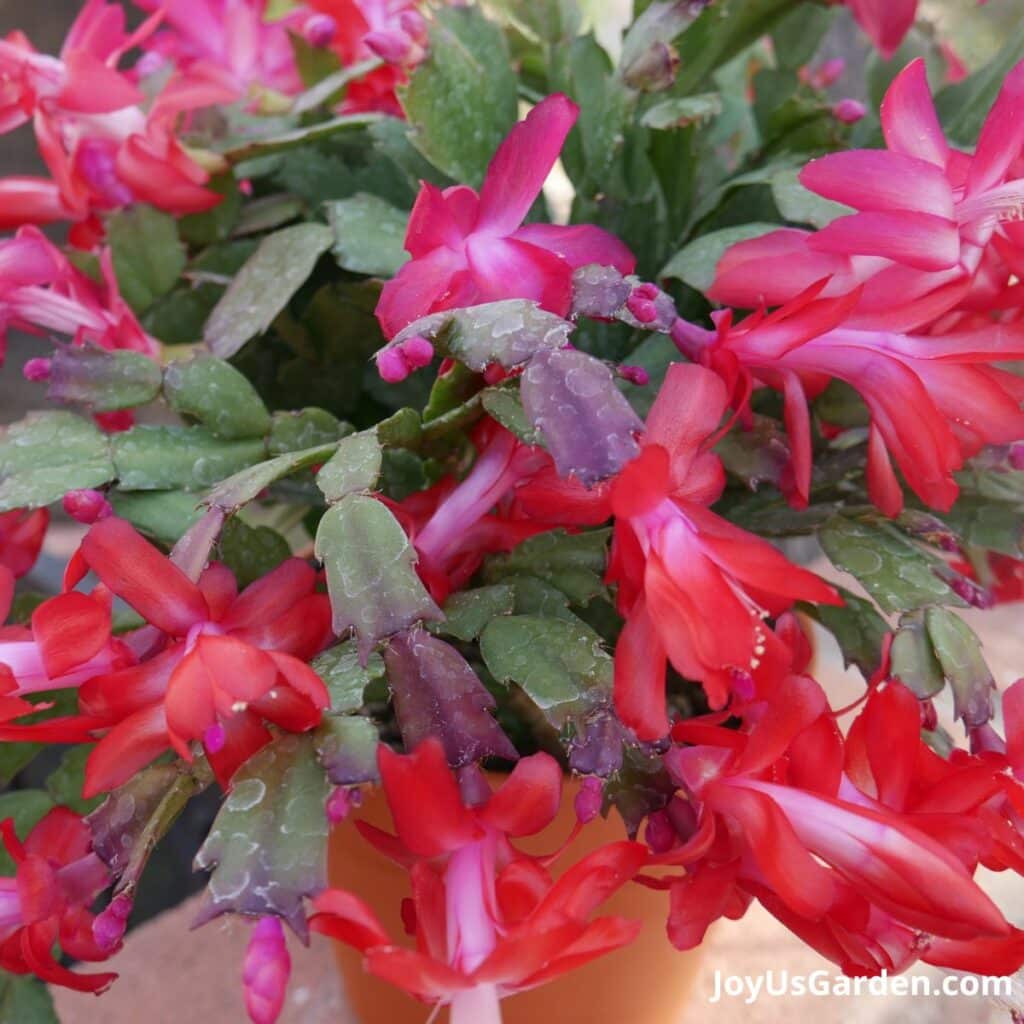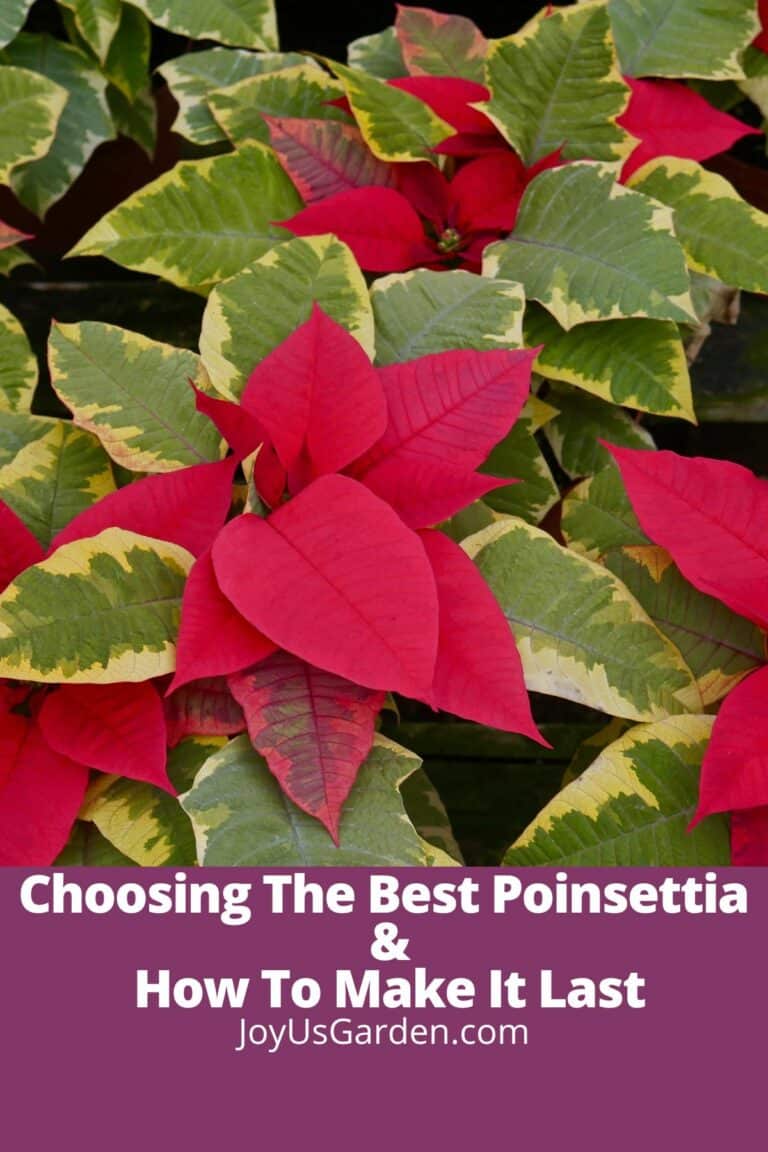22 Christmas Plants and Flowers: Favorites To Decorate Your Home
The holiday season is a great time to welcome a little nature inside and fill your home with festive plants and flowers. From vibrant poinsettias and elegant orchids to ferns and evergreens, these seasonal favorites add warmth, life, and charm to any space. Here, we’ll explore 22 beautiful Christmas plants and flowers that you can use to decorate your home.
Whether you’re styling a festive centerpiece, sprucing up your mantel or hallway, or simply adding a pop of greenery, these ideas will help you create beautiful, lasting displays. Many of these plants also make thoughtful gifts, bringing joy and a touch of nature to anyone lucky enough to receive them. Along with plant choices, you’ll find helpful tips on keeping them fresh and vibrant throughout the season.
Years ago, I owned a commercial Christmas decorating business in San Francisco (Nell Foster Designs) and have used all these plants to create festive displays for clients and in my own home. So, let’s grab your favorite Christmas plants and make your home feel even more magical this season!

Christmas Plants And Flowers
Poinsettia
This is the quintessential flowering plant for Christmas. Poinsettias are typically sold in pots ranging from 4″ – 6″ for smaller plants to 10″ or larger for more mature specimens. They are available in various colors, including traditional red, as well as pink, white, cream, yellow, salmon, and even variegated varieties.
How to use: Displayed on hall tables, side tables, counters, mantels, buffets, mixed gardens, and centerpieces. Larger specimens can be used on the floor.
Learn about poinsettia plant care, plus get tips for choosing the best poinsettia.
Kalanchoe/Calandiva
Kalanchoes are often sold in 4″ to 6″ pots, making them ideal for decorating tabletops or small spaces. The most popular holiday colors are red and white. These long-lasting succulent plants are also sold in pink, yellow, and orange, adding a bright pop of color to your decor if you want to jazz things up and veer from the traditional.
How to use: On table tops, mantels, mixed gardens, and centerpieces.
Get kalanchoe care tips & calandiva care tips here.
Amaryllis
Amaryllis bulbs are typically grown in pots between 6″ and 8″, providing enough space for their large bulbs and blooms. These stunning flowers come in a range of colors, including classic red, white, pink, salmon, and gorgeous multi-color combinations.
How to use: These make an elegant statement when displayed independently. They also look wonderful when grouped en masse in a basket, bowl, or urn.
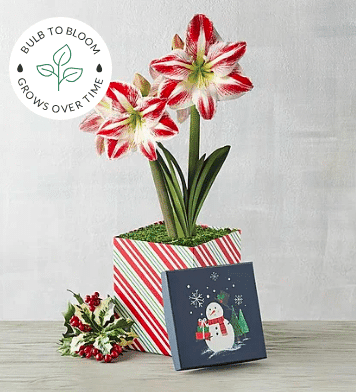
Phalaenopsis Orchid
Phalaenopsis orchids are commonly sold in pots ranging from 3″ to 5″, allowing for optimal drainage and root health. They are available in various colors, including white, pink, purple, yellow, and intricate multi-colored patterns. The blooms arise on long, arching stems and are long-lasting.
How to use: On table tops, in centerpieces, and mixed gardens.
Learn about phalaenopsis orchid care. Here’s a video showing how I made the orchid arrangement on the left side.
Christmas Cactus
Christmas Cacti are sold during the holiday season in bud or bloom. They’re typically sold in pots ranging from 4″ to 8″, giving their arching stems space to spread. The blooms come in festive colors such as red, pink, white, and purple, brightening indoor spaces during the holiday season.
How to use: On table tops, in centerpieces, and mixed gardens.
Get Christmas Cactus care tips, plus learn how to get a Christmas Cactus to bloom again.
Cyclamen
Cyclamen are commonly sold in pots between 4″ to 6″. These low-growing plants are available in a range of colors, including shades of red, white, pink, and purple, with attractive variegated leaves. The mini cyclamens have a slightly sweet/spicy fragrance.
How to use: On table tops, in centerpieces, and mixed gardens.
Miniature Rose
Miniature roses are typically sold in pots ranging from 4″ to 6″, making them ideal for small spaces. They come in a variety of colors, including red, pink, yellow, white, and even bicolor varieties, adding classic charm to any setting.
How to use: On table tops, in centerpieces, and mixed gardens.
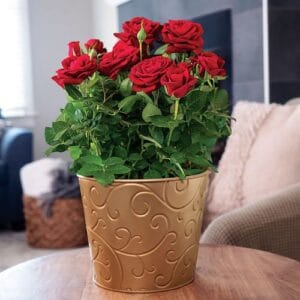
Paperwhite Narcissus
Paperwhites are often sold in pots around 4″ to 6″, giving ample space for multiple bulbs and their tall, slender stems. They’re known for their delicate white blooms that add elegance to indoor displays. Plus, they’re a great choice if you’re looking for fragrance. You can also buy the bulbs and plant them in a container of choice.
How to use: Paperwhites look best displayed with multiple bulbs in one pot. Use them on table tops, in centerpieces, and mixed gardens.


Guzmania
Red Guzmania plants are usually sold in pots between 4″ to 6″ inches, allowing their vibrant flower spikes to be a focal point. While red is the most popular color for the holidays, guzmanias also come in shades of white, yellow, orange, and pink, adding a tropical, modern flair to indoor spaces.
How to use: On table tops, in centerpieces, and mixed gardens. Guzmanias are bromeliads, meaning they’re easy to care for and provide long-lasting color.
Get guzmania care tips here.
Anthurium
Red anthuriums are commonly sold in pots ranging from 4″ to 6″. While red is the most popular holiday color, anthuriums also come in shades of white and pink. These tropical plants have glossy flowers and foliage for the holidays and year-round beauty.
How to use: On table tops, in centerpieces, and mixed gardens. The flowers live for up to twelve weeks. I have an anthurium “fire glow” in my kitchen, and it’s been blooming for over a year.
Learn about anthurium care here.
Rosemary
Rosemary comes in 4″ and 6″ pots up to 1 gallon. I’ve seen it sold in beautiful topiary shapes, including classic Christmas tree forms and elegant single and double balls.
How to use: Mixed gardens and centerpieces. Larger ones can be displayed on hall tables, side tables, and buffets.

Succulents
Succulents come in 2″, 4″ and 6″ pots. There are many to choose from in different colors, shapes, heights, and textures.
How to use: They’re great in mixed gardens and centerpieces. You can also DIY succulent Christmas trees and ornaments.
Do you like the arrangements pictured below? Learn how to make these succulent gardens for Christmas. Details on indoor succulent care.
English Ivy
English ivy comes in 4″, 6″, and 8″ pots. It’s often sold in topiary form (ball, heart, tree, and ball) and comes in dark green, grey-green, and variegated with different leaf shapes.
How to use: Smaller ivy plants can be tucked into mixed gardens and centerpieces. Larger ivies with trails are stunning, cascading off a mantel, bookcase, shelf, or buffet.
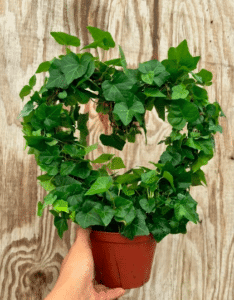
Holly
Holly plants come in 6″, 8″, and 1-gallon pots in shrub and tree form. It’s commonly sold in solid green, but you might be able to find it variegated.
How to use: Smaller plants can be tucked into mixed gardens and centerpieces. Larger ones can be displayed on tables, mantelpieces, counters, and shelves.

Norfolk Island Pine
Norfolk Island Pines come in 6″ pots up to 5 gallon and 14″ pots in heights from 2′ up to 6′.
How to use: They have a graceful look and are generally sold as floor plants to be used as a Christmas tree substitute. If your house has enough light, you can try to grow one as a houseplant and use it the next year.

Miniature Evergreens
These come in 4″ and 6″ pots, up to 5 gallon. The most commonly sold are spruce and juniper in dark green; you can often find chartreuse (pictured below).
How to use: In gardens, on tabletops, and the larger ones can be used on the floor. Small ones are great to use as accent decor if you create a Christmas village or any type of nature scene.
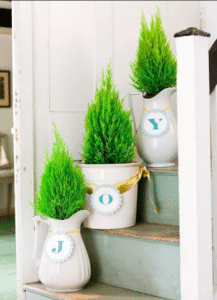
Selaginella
Selaginella is sold in 4″ and 6″ pots. It comes in shades of green and chartreuse and looks like magical Christmas moss.
How to use: Mixed gardens and centerpieces. When I had my Christmas decorating business, this was my favorite plant to use in mixed gardens because it gave a mossy, woodsy look.

Maidenhair Fern
Maidenhair Ferns come in 4″, 6″ and 8″ pots. They’re chartreuse green, and add a lacy, ethereal look.
How to use: In mixed gardens and centerpieces. As pictured below, it makes a beautiful underplanting.

Boston Fern
Boston Ferns come in 4″, 6″, 8″ pots up to 10″ hanging baskets.
How to use: In mixed gardens and centerpieces. The larger ones can be used as underplantings. This plant gives a lush woodland look.

Olive
Olive comes in 4″ and 6″ pots up to 1 gallon. When living in California, I saw it for sale as topiaries, both in Christmas tree form and single and double balls.
How to use: Mixed gardens and centerpieces. The larger ones can be displayed on hall tables, side tables, and buffets. It adds a chic, modern touch with a hint of Mediterranean aesthetic to your home.
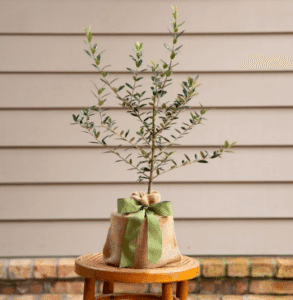
Caladiums
Caladiums are usually sold in 6″ pots. You can also buy the bulbs and grow them yourself. The green/white and red/green varieties are popular at Christmas.
How to use: In mixed gardens and tabletop displays. They bring a bold splash of color to any space.

Air Plants
Air Plants come in different sizes, textures, and shapes.
How to use: You may not think of using air plants, but they work well with modern decor and can easily be tucked into centerpieces and table decor and used in or on top of ornaments. I’ve also seen a couple of air plant Christmas trees.
Learn how to care for air plants and 10 ways to hang air plants.

Display Ideas
There are many ways to display Christmas plants around your home! For a festive centerpiece, group a few smaller plants like poinsettias, mini cyclamen, or mini roses on a tray or piece of wood or stone and accent them with ivy, ornaments, berries, or pinecones.
You can also tuck evergreen sprigs around the pots for an extra seasonal touch. A larger plant, like a poinsettia tree or Norfolk Island pine, can make a statement by being displayed on the floor in the entryway or living room.
Mantels are another great spot to showcase holiday greenery, provided the fireplace isn’t roaring all day and night. Line up a mix of trailing ivy, miniature evergreens, and small potted poinsettias or kalanchoes along the mantel, weaving in fairy lights for extra sparkle.
Don’t forget about tabletops, buffets, shelves, or even the kitchen or bathroom counter to keep the holiday spirit going strong in your home. Small plants arranged in clusters are as impactful as larger plants displayed singly.
Try grouping plants by color theme. For example, display white poinsettias with silver ornaments or combine red flowers with rustic accents. Flowering plants like amaryllis, anthuriums, guzmanias, and phalaenopsis orchids give a modern, elegant look, whereas poinsettias, mini roses, and cyclamen give a more traditional look. To tie them into your decor, you can also wrap pots with festive fabric, foil, ribbons, or burlap.
No matter how you style your plants, the most important thing is to have fun and let your creativity shine!
We have more guides to interest you at this time of year. Check out white blooming plants for Christmas and 13 Christmas plants other than poinsettias.

Tips For Keeping Your Christmas Plants and Flowers Looking Good
To keep your Christmas plants looking fresh, start by giving them the right light, water, and temperature conditions. Many of these festive plants, like poinsettias, Christmas cacti, rosemary, and olive, prefer bright, indirect light, while others, like amaryllis, paperwhites, reindeer moss, and maidenhair fern, can tolerate lower light.
While many need bright light to look their best, keep them out of sunny windows where they could burn. Conversely, keep them out of cold, frosty windows. Keep your plants away from cold drafts, heating vents, and roaring fireplaces, as sudden temperature changes can cause leaves and flowers to droop or drop prematurely.
Watering is also key to keeping your plants happy. Check the soil regularly—most holiday plants prefer to stay lightly moist but not soggy. Overwatering can lead to root rot, while underwatering may cause flowers to wilt or dry out. If you’re displaying plants in festive pots or pot coverings like foil or burlap without drainage holes, take them out to water and let them drain fully before returning them.
When watering, remember that plants in 4″ pots dry out more quickly than those in 6″ or 8″ pots. If your home is warm, you’ll need to check them more frequently, but if it’s cooler, they won’t need watering as often.
Here are a few tips to make your flowers last longer. If you turn your heat back at night to around 60-65 degrees F, your plants will be happier. The warmer you keep your house, and the more sun they’re exposed to, the faster the flowers will open up. That means the bloom time will be shorter. If you buy your flowering plants in bud and have them in lower light conditions, they may not fully open up.
If possible, I buy flowering plants half open and half closed. That way, I have some blooms to enjoy right away, and some later. I buy my poinsettias around Thanksgiving and have them last through January.
With a little care and attention, your holiday plants will thrive, keeping your home merry and bright through the Christmas season well into the New Year!
Conclusion: With so many beautiful Christmas plants and flowers to choose from, it’s easy to bring the spirit of the season into every room of your home. Whether you go for classic favorites like poinsettias and amaryllis or try something new, like a rosemary topiary or a succulent garden, these festive plants will add much color and warmth to your holiday decor.
Just a little care will keep them looking fresh, spreading a touch of nature and joy throughout the season. No matter how you style them, these plants make your indoor space feel even more magical. So, have fun decorating, enjoy the beauty they bring, and maybe even share a few as living gifts to spread the cheer.







